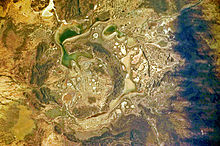Shoemaker impact structure
| Shoemaker crater | |
|---|---|
| Teague Ring | |
 Shoemaker crater from space | |
| Impact crater/structure | |
| Confidence | Confirmed |
| Diameter | minimum 30 km (19 mi) |
| Age | 1630 ± 5 Ma (contested, see text) Proterozoic |
| Exposed | Yes |
| Drilled | No |
| Location | |
| Coordinates | 25°52′S 120°53′E / 25.867°S 120.883°E |
| Country | |
| State | Western Australia |
| District | Mid West |
Shoemaker (formerly known as Teague Ring) is an impact structure, the deeply eroded remnant of a former impact crater, situated in arid central Western Australia, about 100 km (62 mi) north-northeast of Wiluna.[1] It is named in honour of planetary geologist Eugene Shoemaker.[2]
Description

The prominent ring-like topographic feature, easily seen in satellite images, lies on the boundary between the Palaeoproterozoic Earaheedy Basin and the Archaean Yilgarn Craton. The area contains a number of seasonal salt lakes, the largest being Lake Teague.
The first suggestion that the ring-like topographic feature may be an impact structure was published in 1974.[3] Subsequent research revealed definitive evidence for this hypothesis, including the presence of shatter cones and shocked quartz.[4][5][6] The feature has a central circular region of uplifted Archaean Granite (Teague Granite) about 12 km (7.5 mi) in diameter, surrounded by a downwarped ring (ring syncline) of sedimentary rocks with an outer limit of disturbance at about 30 km (19 mi) diameter, which is a minimum estimate of the size of the original crater.[5]
The age of the impact event is uncertain. It must be younger than the Teague Granite in the centre, dated at 2648 ± 8 Ma (million years ago).[5] The most commonly cited age of about 1630 Ma[4] represents a re-heating event affecting the granite; while this may be the impact event it could simply be a regional tectonic event.[5] More recent dating by K–Ar methods yield ages as young as 568 ± 20 Ma,[7] this age could also date the impact event or represent tectonic activity.[5]
See also
References
- ^ "Shoemaker". Earth Impact Database. Planetary and Space Science Centre University of New Brunswick Fredericton. Retrieved 2017-10-09.
- ^ Pirajno F. & Glikson A.Y. 1998. Shoemaker impact structure Western Australia (formerly Teague ring structure). Celestial Mechanics and Dynamical Astronomy 69, 25–30.
- ^ Butler H. 1974. The Lake Teague ring structure, Western Australia: an astrobleme? Search 5, 536–537.
- ^ a b Bunting J.A., De Laeter J.R. & Libby W.G. 1980. Evidence for the age and cryptoexplosive origin of the Teague Ring structure, Western Australia. Geological Survey of Western Australia, Annual Review 1980, 81–85. GSWA download search Archived 2009-07-13 at the Wayback Machine
- ^ a b c d e Pirajno F., Hawke P., Glikson A.Y., Haines P.W. & Uysal T. 2003. Shoemaker impact structure, Western Australia. Australian Journal of Earth Sciences 50, 775–796. Abstract
- ^ Shoemaker E.M. & Shoemaker C.S. 1996. The Proterozoic impact record of Australia. AGSO Journal of Australian Geology and Geophysics 16, 379-398.
- ^ Pirajno F. 2002. Geology of the Shoemaker impact structure. Geological Survey of Western Australia Report 82. GSWA download search Archived 2009-07-13 at the Wayback Machine



